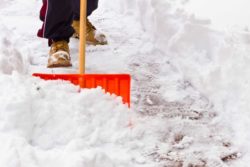
Shovelling Snow Safety Talk
Winter weather brings many hazards for those individuals who have to experience it where they live and work. Whether it is driving in poor conditions or having to clear snow, any task done in winter weather conditions often results in a higher chance of injury. One winter weather work task that can easily result in injury is shovelling snow.
Snow Shovelling Injuries
Shovelling snow is a straight forward process, but it is a work task that often ends in injury both on the job and at home.
- Overworking your muscles, falling, and being hit with the shovel were the most common reasons for getting injured.
- Muscle, ligament, tendon, and other soft tissue injuries topped the list of snow shovelling mishaps. Lower back injuries were common.
- Other common snow shovelling injuries included cuts and broken bones. The arms and hands were the most likely body regions to sustain a bone fracture.
- Heart-related problems made up only 7% of snow shovelling injuries. However, all deaths due to snow shovelling were caused by heart problems.
- Adults over 55 were over four times more likely than younger people to have heart-related symptoms while shovelling.
Best Practices to Avoid Injury While Shovelling Snow
- Prior to consider shovelling as your only option consider mechanical methods to clear snow such as a vehicle with a plow or snow blower.
- If you do have to shovel, take time to warm up or properly stretch prior to starting.
- Do not overexert yourself. If you are not used to a heavy physical workload or have health issues take your time while shovelling snow. Depending on the severity of any health issues consider eliminating shovelling altogether by having someone else complete the task.
- Use proper work posture when shovelling. Avoid actions such as rounding your back or twisting when lifting.
- Always lift with your legs and not with your back.
- When possible, push the snow out of the way to limit lifting and throwing the snow. Pushing the snow is less hazardous than lifting and throwing snow.
- Use an ergonomically-friendly snow shovel. While the overall design of snow shovels are basically the same there are many that have been designed with the human body in mind.
- Watch your step and ensure you are wearing the proper footwear for the task. Preventing slips, trips, and falls in winter weather conditions can be extremely difficult to do. Having the proper footwear and taking your time while walking can reduce the chance of these incidents occurring.
Summary
While the task of shovelling snow is a straightforward one there are many injuries that can occur while performing this task. Consider the injuries mentioned in this talk and the steps you can take to avoid an injury the next time you have to shovel snow.
